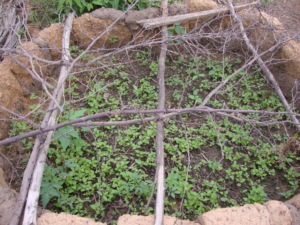I arrived in Bamako and jumped right in to working by spending my first two days in the field meeting with and talking to vegetable farmers to learn about their typical growing practices. myAgro is in the process of expanding its agricultural packages to include vegetables, to add another avenue for farmers to increase their incomes. This year, five vegetable packages will be offered for purchase, including seeds, fertilizer and expert training and support for 100m2 plots of land. The five vegetables are cabbage, okra, onions, peppers and tomatoes.
On August 1st, in the village of Gwelekoro, I sat down under a mango tree and talked with a farmer who has been planting a variety of staple crops and vegetables on his five hectares of land. He started planting corn using the myAgro method last season and is very pleased with his farm and the increases he received. Because of this impact, he has already started saving for the tomato package because he said that he believes that there will be a dramatic increase in his yield if he follows the myAgro method. I asked him what he thinks some of the biggest constraints he faces in vegetable production and he said there were three main problems; fertilizer is expensive, there is a lack of irrigation capacity in the dry season and many of the plants die during transplanting. His answers helped us to create the training for the packages so that we design our teachings to address these constraints. After speaking to a number of farmers in various villages that regularly plant vegetables, farmers across the board listed the same problems as the farmer in Gwelekoro. To help with fertilizer, the myAgro packages include NPK and we will train the farmers to make starter solution to boost the plants growth after transplant. To help with water conservation, the training will include teaching a new planting bed preparation called waffle beds that use 2-4” berms (ridges) around the waffle squares. The depressions help to keep the water in the plot and make watering by hand more efficient as all the water used goes directly to the roots.

myAgro agents watering a recently planted gombo (okra) test plot. The waffle bed design is great for growing vegetables in the dry season as it conserves scarce water resources.
Finally, to address the problem with transplanting, the training package will

Traditional seedbed preparation (broadcasted)
offer specific training in preparing seedbeds and how to properly transplant seedlings to the waffle beds without destroying roots that cause high levels of seedling mortality. or this, we will be teaching the farmers to plant their nurseries in rows and not in the traditional broadcasting method where seed is just thrown into a seedbed. From this small tweak, we should already see a big change in harvests – from our estimates anywhere from 25 – 50% of seedlings die in the transplanting process so this small – but key – change will be a big boost to the final number of healthy plants that are able to take root.